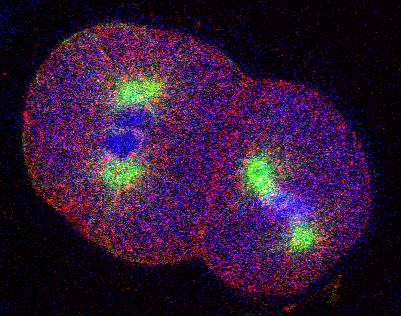Image denoising
High-quality denoising of multidimensional fluorescence microscopy images
 |  |
| Before denoising | After denoising |
Outline
The incessant development of improved microscopy imaging techniques, as well as the advent of highly selective fluorescent dyes has made possible the precise identification of tagged molecules in almost any biological specimen. Of particular interest are the visualization and the study of living cells, which induce tight constraints on the imaging process. To avoid the alteration of the sample and to achieve a high temporal resolution, low fluorophore concentrations, low-power illumination and short exposure time need to be used in practice. Such restrictions have a tremendous impact on the image quality. This is why we have recently introduced a new method, coined PURE-LET [1,2,3], for efficient, fast, and automatic denoising of multidimensional fluorescence microscopy images.
References
[1] F. Luisier, C. Vonesch, T. Blu, M. Unser, "Fast Interscale Wavelet Denoising of Poisson-corrupted Images", Signal Processing, vol. 90, no. 2, pp. 415-427, February 2010.
[2] F. Luisier, "The SURE-LET Approach to Image Denoising", Swiss Federal Institute of Technology Lausanne, EPFL Thesis no. 4566 (2010), 232 p., January 8, 2010.
[3] F. Luisier, C. Vonesch, T. Blu, M. Unser, "Fast Haar-Wavelet Denoising of Multidimensional Fluorescence Microscopy Data", Proceedings of the Sixth IEEE International Symposium on Biomedical Imaging: From Nano to Macro (ISBI'09, Boston MA, USA, June 28-July 1, 2009, pp. 310-313.
ImageJ Plugin
Warning
The ImageJ plugin is well adapted to denoise images mainly corrupted by Poisson noise which is typically the case for fluorescence microscopy data. It doesn't properly work for other distributions of noise or for saturated images.
Specification
PureDenoise is a Java software package that performs fast, automated, high-quality denoising of multidimensional images corrupted by mixed Poisson-Gaussian noise. It is therefore particularly well-adapted to fluorescence microscopy data. Its main features are the following:
Screenshots
ImageJ prerequirements
The software provided here is a plugin for ImageJ, a general purpose image-processing and image-analysis package. ImageJ has a public domain licence; it runs on several plateforms: Unix, Linux, Windows, Mac OS 9 and Mac OS X. It doesn't take more than a couple of minutes to install.
Download and install
| Distribution for end-users | Distribution for macro or development |
| Download the ImageJ plugin PureDenoise_.jar. | Download PureDenoise.zip, the ImageJ's plugin. |
| Put the file PureDenoise_.jar in the plugins folder of ImageJ without unzip it. |
Unzip the file PureDenoise.zip and put it into the plugins folder of ImageJ. Macro: The syntax of the macro is described in this following example Macro-Example-PureDenoise.txt. |
| The JAR file includes the Java classes, sources, and documentation. | The ZIP file includes the Java classes, sources, and documentation. |
Instructions
Example of performances
Here are some results obtained with ImageJ (64-bit) 1.44h on an Intel Core i7 720QM (4x1.6GHz) for the following 400x400x10 dataset. The simulated noisy data have a signal-to-noise ratio (SNR) of 9.45 dB. The actual gain (α) and offest (δ) of the detector are set to 1 and 0, respectively. The standard deviation (σ) of the additive white Gaussian noise is set to 1. The automatically estimated parameters (used in the experiments below) are: &alpha=0.99;, &delta=0.04; and &sigma=1.01;.
SNR Performance in [dB]
| Cycle-spin/Multiframe | 1 | 3 | 5 | 7 |
| 1 | 19.00 | 21.09 | 21.67 | 21.88 |
| 2 | 19.06 | 21.15 | 21.73 | 21.96 |
| 4 | 19.78 | 21.87 | 22.44 | 22.65 |
| 8 | 20.05 | 22.16 | 22.73 | 22.95 |
Computation Time in [s]
| Cycle-spin/Multiframe | 1 | 3 | 5 | 7 |
| 1 | 2.4 | 4.1 | 5.6 | 7.6 |
| 2 | 4.2 | 8.0 | 10.6 | 13.3 |
| 4 | 7.6 | 14.4 | 20.7 | 25.7 |
| 8 | 13.8 | 28.8 | 39.7 | 50.7 |
Conditions of use
You'll be free to use this software for research purposes, but you must not transmit and distribute it without our consent. In addition, you undertake to include a citation whenever you present or publish results that are based on it. EPFL makes no warranties of any kind on this software and shall in no event be liable for damages of any kind in connection with the use and exploitation of this technology.
Related Works
SURE-LET for denoising images corrupted by additive white Gaussian noise.Acknowledgements
Thierry Blu, Sathish Ramani, Daniel Sage and CÚdric Vonesch for their useful contribution.